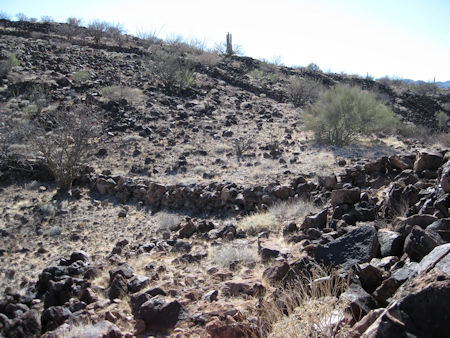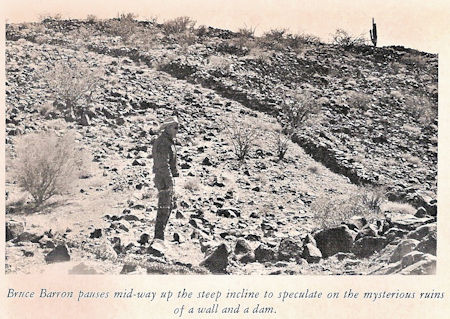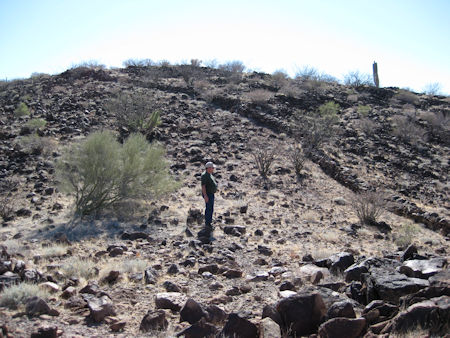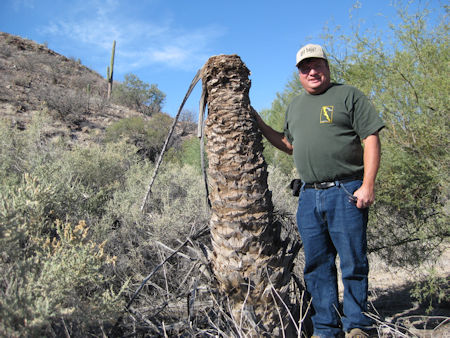 |  |
By David Kier

Time for us to examine again an unsolved mystery I first wrote about many years ago. The story begins even earlier: In 1966, an expedition led by Erle Stanley Gardner was exploring along an abandoned mine road south from Bahía de los Ángeles. They hoped to use it to get to El Barril and continue on south. A discovery of strange walls on a hillside overlooking a bay was made. A date-palm, indicating fresh water was close to the surface, was found at the base of a hill. Also, a ruined dam and reservoir were nearby. On the expedition was historian-author and then the editor of Desert Magazine, Choral Pepper. She was intrigued by these odd walls as to who built them and for what purpose. Pepper later wrote about that discovery in her magazine and included it in her popular 1970’s book, Baja California: Vanished Missions, Lost Treasures, Strange Stories, Tall and True.
Erle Stanley Gardner, considered the finest mystery author of the 20th century and creator of Perry Mason, had a huge fascination with the desert and with Baja California, authoring several books about his expeditions that included many four-wheel-drive vehicles, special dune buggies, off road scooters, and ATVs. These expeditions were financed in part from his Perry Mason TV show royalties. Uncle Erle (as he was known to his friends) was even able to get helicopters to be a part of some of his expeditions. Many cave painting sites were found on some of his expeditions that could not be seen from the ground. Gardner is credited with exposing the giant cave art of Baja to the outside world. Gardner always found interesting people or places during his Baja expeditions and his many Baja adventure books shared them.
The new book Gardner would write from this latest expedition was Off the Beaten Track in Baja, published in 1967. It combined various trips but primarily was about the February 1966 trip. The book did not mention the ruins they discovered but did include their time at Las Animas Bay. It is this unusual omission of such a discovery that adds a lot of mystery. Choral Pepper’s chapters about the site give us the carrot of interest. Archeologists led by Dr. Eric Ritter have studied the region of Bahía las Animas to learn more about the Natives who lived there. Dr. Ritter did not mention the walls in his paper.

One of the expedition members thought the walls must have been a corral, but Gardner quickly pointed out it was a “hell-of-a-spot” for a corral! They were on the side of a hill, and not enclosed. The date palm and apparent age of the ruins were the most intriguing part. The rocks used to make the wall were coated with desert varnish, a mineral coating from intense heat that can take centuries to form.
On the top of the hill, beyond the walls, were several Native sleeping circles and in them, many clam shells. The gulf coast is 2 miles away and the clams were a major food source. The ruins of a dam and reservoir as well as the walls and date palm all point to Spanish-era activity. The sleeping circles could be from pre-Spanish habitation or during the Spanish period. The Jesuit explorer, Fernando Consag, visited Las Animas Bay in 1746 seeking new mission sites and converts. A map made in 1757 reflects the voyage of Padre Consag and places a proposed mission, named Santa María Magdalena in this general area, south of Bahía de los Angeles. The map lists the mission as “started” and is placed north of another proposed mission, Dolores del Norte. Dolores del Norte was renamed Santa Gertrudis in 1752 when it was officially founded. Hanging at that mission is a bell, named Santa María Magdalena, maybe destined for the next mission north?
It was theorized by Choral Pepper that Mission Santa María Magdalena was begun, as Jesuit papers and maps showed, but the location was abandoned before very long. Possibly the spring which once filled the reservoir had stopped flowing? Whatever the reason, enough labor was provided to build the dam, reservoir, walls, and maybe other structures no longer visible. The location has a commanding view of both the sea and the desert far off, to provide good defense.
A mission named “Santa María Magdalena” is shown on some modern maps a few miles northwest of Mulegé. This error dates back to Arthur North’s expedition of 1905-1906 when he camped by stone ruins locals said were called La Magdalena. Arthur North had read the Jesuit documents available and learned of the proposed mission called Santa María Magdalena, in the north. Not considering there could be more than one Magdalena, he applied that mission name to the ruins near Mulegé. Many books and maps continued that error.

When I interviewed Choral Pepper about the mysterious walls south of L.A. Bay, some 18 years ago, she did not have the exact location in her memory but recalled it was in sight of the sea. She wished me success in my quest to find the lost missions. I telephoned three other members of that expedition (J.W. Black, Bruce Barron, and Ricardo Castillo) and none remembered the exact location. I next made four trips south to try and find the walls, dam, and palm tree between 2001 and 2004. I concentrated on the road they used and had partially constructed in 1966. I even drove to Bahía las Animas but missed seeing the walls up on the hill. An Internet Baja enthusiast spotted lines on Google Earth imagery and showed them to me to see if they could be what I was looking for. My reply was that I had to go in person and look! In January 2009, my wife and I headed south to that hill with the lines, 35 miles from L.A. Bay.
The road into Bahía las Animas splits and most traffic takes the left fork, as I had done in 2004. This time, I used the right fork. As the road came along the hillside, there was the ruined dam and reservoir. We got out to check it out and took photos. Then we drove a bit further, rounding a bend at the foot of the hill, and there it was, the palm tree! It was just a scraggly looking trunk, exactly as Choral had described 43 years earlier. I was overwhelmed that we found the site and how little it has changed in all the years. We drove past the palm and bushwhacked to what looked like a good place to climb the hillside. The walls are not visible from this road, but they are seen from the other side, on road to the bay.
We climbed up the steep side and at the first ridgetop, there they were, two walls so oddly located up there. We continued and took photos trying to match the same spot where Choral Pepper took photos 43 years earlier. At the top of the hill, beyond the second wall were several sleeping circles, filled with shellfish pieces. A shallow cave was along the south edge, above the dam, with a commanding view of all who would approach from the south. All in all, it was a most rewarding experience. Regretfully, Choral Pepper passed away in 2002 before I found the site. I think I felt her spirit guiding me that day.
I returned to Las Animas Bay in 2017 to camp and tried to drive to the palm tree from the bay. Flash floods had erased the road that circled the hill where it rejoined the main road. The right fork for the dam/palm/ hill climb area was still visible south of the hill, 7 miles from the main road between Bahía de los Ángeles and Punta San Francisquito. Additional photos at www.vivabaja.com/109.
Desert Magazine (page 20) Historic mysteries, such as this one, helped motivate my research to write the book, Baja California Land of Missions.

About David
David Kier is a veteran Baja traveler, author of 'Baja California - Land Of Missions' and co-author of 'The Old Missions of Baja and Alta California 1697-1834'. Visit the Old Missions website.

I have been insuring my F350 truck in Baja California Sur through Bajabound for a few years and it...

Quick, easy, well designed website and not just for Baja. Good rates for temporal residente...

Easy and fast in less than 10 minutes you could have insurance for Mexico. I have used them for...